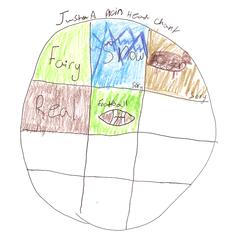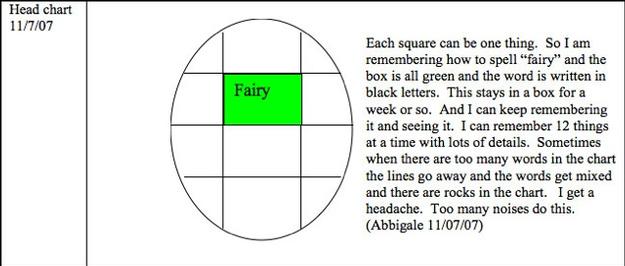|
 |


Home
> Family and Community
> Family Features

|
|
|

|
|
During one of our conversations, in November, three months after I began this investigation, I learned what the boxes were. Learning about the boxes really helped me visualize and understand more what she was explaining. I actually stumbled onto this revelation.
 |
| Abbigale's Plain Head Chart |
 |
One night we were sitting on the bed getting ready to go to sleep. Abbigale started telling me about her science study (it was about snow) that she was doing at school. She told me verbatim things the teacher said. I could tell that she was repeating exact information because of some of the vocabulary. She also gave statistics about snow and snowflakes. It wasn't common vocabulary for Abbigale to use in conversation. After she told me about the science study, she went on to tell me about another project she was working on in school. Again, she used a great many details and new vocabulary words. I happened to ask her how she remembered all the facts and details and I asked if her colors helped her to remember. She smiled and nodded yes. She then went on to tell me that in her head she has a chart and the chart is made up of boxes. In each box, she holds information such as the science study. She said all she has to do is look in that box and all the information is there. I asked her how many boxes she had. She intently stared blankly at me, as if she were looking and counting inside her head. Then she said 12. She ran in the other room and grabbed paper and pen and drew an oval with two lines down and three across (12 boxes). I grabbed my notepad and began recording. She went on to explain her process of how to store information in a box, how long different things could stay in a box, how she could move the boxes around, how the boxes all filled with rocks and she then would get a headache, and how if she had too much information (all the boxes were filled) then she would just get a swirling of all the colors (information). Then she went to bed. I needed some time to process this information.
A couple of days later Abbigale drew many pictures of the boxes. I formulated more questions to ask her and she did her best to describe what she saw. Abbigale was very focused as she "looked inside her head" at her head charts. I could tell that she was actually manipulating the boxes and colors to actually see what I was asking. After each question, she would draw what would happen. See below:
 |
| Abbigale's Head Chart |
 |
|
 |
|
|
| |
| About the Author: Dr. Hilary Seitz is an Associate Professor and the Early Childhood Program Coordinator for College of Education at the University of Alaska Anchorage She has been teaching in the Early Childhood field since 1986 as an infant/toddler teacher, preschool teacher, primary grades teacher in public school, reading teacher, and as a college professor since 2003. Her research interests include: family-community partnerships, early literacy strategies, teacher research and reflection using observations and documentation, and currently she is exploring pre-service early childhood teacher education practices. In her free time, she enjoys reading, camping, skiing, hiking, sewing, cooking, and spending time with her family. |
| |
|

|
|
|




